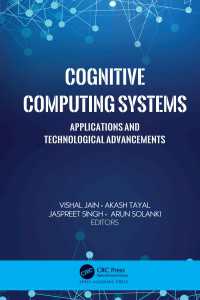基本説明
運動障害の原理と実践についての好評テキスト4年ぶりの改訂版。
A reader-friendly full colour format. 1st ed.: 2007.
Full Description
Principles and Practice of Movement Disorders provides the complete, expert guidance you need to diagnose and manage these challenging conditions. Drs. Stanley Fahn, Joseph Jankovic and Mark Hallett explore all facets of these disorders, including the latest rating scales for clinical research, neurochemistry, clinical pharmacology, genetics, clinical trials, and experimental therapeutics. This edition features many new full-color images, additional coverage of pediatric disorders, updated Parkinson information, and many other valuable updates. An accompanying Expert Consult website makes the content fully searchable and contains several hundred video clips that illustrate the manifestations of all the movement disorders in the book along with their differential diagnoses.Get just the information you need for a clinical approach to diagnosis and management, with minimal emphasis on basic science.Find the answers you need quickly and easily thanks to a reader-friendly full-color format, with plentiful diagrams, photographs, and tables.Apply the latest advances to diagnosis and treatment of pediatric movement disorders, Parkinson disease, and much more. View the characteristic presentation of each disorder with a complete collection of professional-quality, narrated videos online.Better visualize every concept with new full-color illustrations throughout. Search the complete text online, follow links to PubMed abstracts, and download all of the illustrations, at www.expertconsult.com.Drs. Fahn, Jankovic and Hallett provide you with the guidance you need to diagnose and manage the full range of movement disorders.
Contents
Section I1. Clinical overview and phenomenology of movement disorders 2. Motor control: Physiology of voluntary and involuntary movements 3. Functional neuroanatomy of the basal ganglia Section II: Hypokinetic disorders4. Parkinsonism: Clinical features and differential diagnosis 5. Current concepts on the etiology and pathogenesis of Parkinson disease 6. Medical treatment of Parkinson disease 7. Surgical treatment of Parkinson disease and other movement disorders 8. Nonmotor problems in Parkinson disease 9. Atypical parkinsonism, parkinsonism-plus syndromes, and secondary parkinsonian disorders 10. Gait disorders: Pathophysiology and clinical syndromes 11. Stiffness syndromes Section III: Hyperkinetic disorders12. Dystonia: Phenomenology, classification, etiology, pathology, biochemistry, and genetics 13. Treatment of dystonia 14. Huntington disease 15. Chorea, ballism, and athetosis 16. Tics and Tourette syndrome 17. Stereotypies 18. Tremors 19. The tardive syndromes: Phenomenology, concepts on pathophysiology and treatment, and other neuroleptic-induced syndromes 20. Myoclonus: Phenomenology, etiology, physiology, and treatment 21. Ataxia: Pathophysiology and clinical syndromes 22. The paroxysmal dyskinesias 23. Restless legs and peripheral movement disorders 24. Wilson disease 25. Psychogenic movement disorders: Phenomenology, diagnosis, and treatment Index
-

- 洋書電子書籍
- Cognitive Computing…
-

- 電子書籍
- ガチ恋粘着獣 ~ネット配信者の彼女にな…






